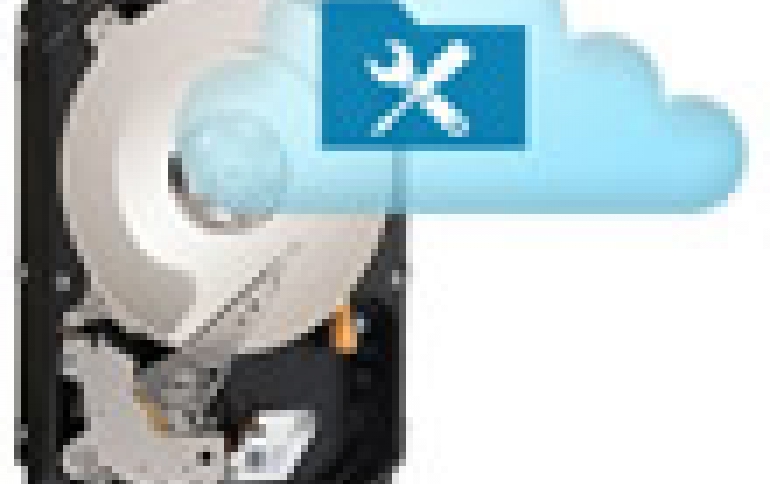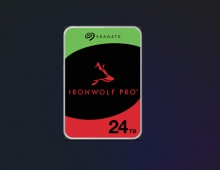
Seagate Kinetic Open Storage Delivers Simpler Cloud Architecture
Seagate today unveiled its internally developed Seagate Kinetic Open Storage platform, designed to simplify data management, improve performance and scalability while lowering total cost of ownership (TCO) of average Cloud infrastructures.
"With the Seagate Kinetic Open Storage platform, our internal R&D teams have designed an unique, first-of-its-kind storage architecture to enable cheaper, more scalable object storage solutions that free up IT professionals from having to invest in hardware and software they don't need - while empowering them with the most innovative storage technology available," said Rocky Pimentel, Seagate executive vice president and chief sales and marketing officer. "This technology optimizes storage solutions for a new era of cloud storage systems, while drastically reducing overall costs."
The Seagate Kinetic Open Storage platform eliminates the storage server tier of traditional data center architectures by enabling applications to speak directly to the storage device, thereby reducing expenses associated with the acquisition, deployment, and support of hyperscale storage infrastructures.
Current data centers are characterized by multiple layers of software and hardware stacked together in order to enable a data path between two poorly compatible systems: an object-oriented application layer and a hardware layer (spanning HDDs, SSDs and tape) based on block-storage. The transit path from application to storage requires multiple layers of manipulation from databases, down through POSIX interfaces, file systems, volume managers and drivers. Information passes over Ethernet, through Fibre Channel, into RAID controllers, SAS expanders and SATA host bus adapters.
Beyond the obvious inefficiency of having to move through multiple layers, this model relies on an outdated assumption about the operation of local storage devices, which was organized close to, and based on, the physical attributes of a device.
In order to manage this complexity, an entire ecosystem of storage server technology providers (both hardware and software) has developed purely to abstract it from both the device and the application layers. Not only is this inefficient, it also introduces additional barriers between the two sides that can impede surfacing of storage features and functionality.
 The Seagate Kinetic Storage platform allows object-oriented applications to connect directly to in the language of the storage device.
The Seagate Kinetic Storage platform allows object-oriented applications to connect directly to in the language of the storage device.
The platform integrates a new key/value API - which will be open sourced - and Ethernet connected with Seagate hard drive technology. Designed for rapid implementation and deployment in any cloud storage software stack, this technology can be deployed across a portfolio of storage devices enabling system builders and software developers to design new solutions that will deliver against a full array of cloud data center use cases.
Specific Seagate drives are provided with a user-space library that allows applications to access the drive directly. This library provides the complete interface to access the data and to manage the drive. It bypasses the normal operating system storage stack and lets the application talk directly to the drive as if it were talking to another service in the data center. This process utilizes a typical application remote procedure call (RPC). This Kinetic Storage API platform currently provides libraries for Java, C++, C, Python, and Erlang.
With Kinetic Storage APIs, data can be easily shared between applications from multiple sources. One application can write a key and value to a drive, while another has the ability to read the data.
Traditionally, moving data from one drive to another required routing it through expensive storage servers. With Kinetic Storage APIs, data can now be moved directly between drives with peer-to-peer data copy commands where ranges of keys can be moved between drives.
With Kinetic Storage, data can be also stored with comprehensive end-to-end integrity checks that ensure the data was received at the drive correctly, allowing the drive and the ultimate recipient to be able to guarantee that the data is still correct.
The interface library supports a full cryptographic authentication of servers that have access permission to the drive; full integrity check of the command and the data; a set of roles by server as to what the application is allowed to do - read, read/write, management of the drive and management of the security in the drive and; for the security of very sensitive data and/or management commands, a full industry-standard Transport Layer Security (TLS) suite is also provided.
The platform enables cloud service providers and independent software vendors to optimize scale-out file and object-based storage. With the Kinetic Open Storage platform, applications can now manage specific features and capabilities and implement and deploy in any cloud storage software stack. The technology also increases I/O efficiency by removing bottlenecks and optimizing cluster management, data replication, migration, and active archive performance.
Open source Cloud hardware and software providers including Basho, Dell, EVault, Huawei, Hyve Solutions, Rackspace, Newisys, Supermicro, SwiftStack and Xyratex are now developing on Seagate's new platform.
The Seagate Kinetic Open Storage platform eliminates the storage server tier of traditional data center architectures by enabling applications to speak directly to the storage device, thereby reducing expenses associated with the acquisition, deployment, and support of hyperscale storage infrastructures.
Current data centers are characterized by multiple layers of software and hardware stacked together in order to enable a data path between two poorly compatible systems: an object-oriented application layer and a hardware layer (spanning HDDs, SSDs and tape) based on block-storage. The transit path from application to storage requires multiple layers of manipulation from databases, down through POSIX interfaces, file systems, volume managers and drivers. Information passes over Ethernet, through Fibre Channel, into RAID controllers, SAS expanders and SATA host bus adapters.
Beyond the obvious inefficiency of having to move through multiple layers, this model relies on an outdated assumption about the operation of local storage devices, which was organized close to, and based on, the physical attributes of a device.
In order to manage this complexity, an entire ecosystem of storage server technology providers (both hardware and software) has developed purely to abstract it from both the device and the application layers. Not only is this inefficient, it also introduces additional barriers between the two sides that can impede surfacing of storage features and functionality.
 The Seagate Kinetic Storage platform allows object-oriented applications to connect directly to in the language of the storage device.
The Seagate Kinetic Storage platform allows object-oriented applications to connect directly to in the language of the storage device.
The platform integrates a new key/value API - which will be open sourced - and Ethernet connected with Seagate hard drive technology. Designed for rapid implementation and deployment in any cloud storage software stack, this technology can be deployed across a portfolio of storage devices enabling system builders and software developers to design new solutions that will deliver against a full array of cloud data center use cases.
Specific Seagate drives are provided with a user-space library that allows applications to access the drive directly. This library provides the complete interface to access the data and to manage the drive. It bypasses the normal operating system storage stack and lets the application talk directly to the drive as if it were talking to another service in the data center. This process utilizes a typical application remote procedure call (RPC). This Kinetic Storage API platform currently provides libraries for Java, C++, C, Python, and Erlang.
With Kinetic Storage APIs, data can be easily shared between applications from multiple sources. One application can write a key and value to a drive, while another has the ability to read the data.
Traditionally, moving data from one drive to another required routing it through expensive storage servers. With Kinetic Storage APIs, data can now be moved directly between drives with peer-to-peer data copy commands where ranges of keys can be moved between drives.
With Kinetic Storage, data can be also stored with comprehensive end-to-end integrity checks that ensure the data was received at the drive correctly, allowing the drive and the ultimate recipient to be able to guarantee that the data is still correct.
The interface library supports a full cryptographic authentication of servers that have access permission to the drive; full integrity check of the command and the data; a set of roles by server as to what the application is allowed to do - read, read/write, management of the drive and management of the security in the drive and; for the security of very sensitive data and/or management commands, a full industry-standard Transport Layer Security (TLS) suite is also provided.
The platform enables cloud service providers and independent software vendors to optimize scale-out file and object-based storage. With the Kinetic Open Storage platform, applications can now manage specific features and capabilities and implement and deploy in any cloud storage software stack. The technology also increases I/O efficiency by removing bottlenecks and optimizing cluster management, data replication, migration, and active archive performance.
Open source Cloud hardware and software providers including Basho, Dell, EVault, Huawei, Hyve Solutions, Rackspace, Newisys, Supermicro, SwiftStack and Xyratex are now developing on Seagate's new platform.





















